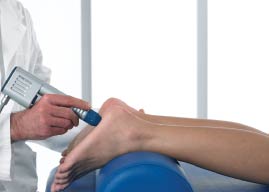Custom Orthotics
Who Needs Orthotics?
If you experience any of the following complaints, you may be a candidate for prescription custom foot orthotics.
- Heel pain
- Arch pain
- Bunions
- Shin splints
- Tired feet
- Flat feet
- Arthritic conditions
- Neuromas
- Calluses
- Back pain
- Knee pain
- Hip pain
- Chronic ankle sprains
The term orthotics can refer to many different devices worn in a shoe. There are however two very different types of devices. The first is a nonprescription device, or arch support. The second is a functional device, which is by prescription only. A functional device is a custom made device designed to correct the patient’s individual foot problem. The above problems may be due to excessive pronation (flat feet) or excessive supination (high arched feet).
Orthotics help to control theses biomechanical imbalances by gently and consistently directing your foot into the correct position for walking, running and standing. Because your foot is now functioning properly, the pain of muscle strain and pressure points is relieved and the progression of deformities is stopped or slowed. They also can halt progression of existing problems relieving pain and allowing healing to occur.
Functional orthotics from your podiatrist can be a very valuable therapy in treating foot problems related to abnormal biomechanics. It is not necessary for every patient to be treated with functional orthotics for a biomechanical problem. Many people are helped by wearing quality over the counter arch supports and the correct shoes. Other conservative modalities, such as stretching and exercises are also helpful and appropriate adjunctive therapies. However, when functional orthotics are needed, be sure that a doctor who is an expert in biomechanics and orthotics therapy be consulted.
How Should Your Foot Be Casted for Custom Orthotics?
There are several methods that can be used to obtain an image of the foot to make custom foot orthotics. The reality is that some work much better than others. Unfortunately not all practitioners use the methods that have been shown to be most effective. This may be because they are not familiar with the literature, because they want a faster or cheaper way to take the imageof the foot, or because they were sold a “computerized” system that looks impressive but does not work particularly well. The most important criteria is the experience and skill of the medical practitioner, but regardless, there are some techniques that have been shown to be much more effective than others. The only method that has been shown in the medical literature to be effective in producing a quality functional custom foot orthotics is a three-dimensional non-weightbearing cast or image of the foot. In this technique the foot is held in a precise position – essentially the position in which it should function. The image of the foot can be taken using plaster, figerglass, or a laser scan.
Who Should Take the Cast?
Casting position is absolutely critical to orthotic outcome. Thus, it is our opinion that only the doctor, and not a staff member, should take the cast off your foot. Before making an appointment to have orthotics made, the first question you should ask is “who will take the cast off my foot – the doctor or an assistant?” If the answer is anyone other than the doctor, go somewhere else.
Are There Other Methods to Take a Cast Off the Foot for Orthotics?
There are 3 other methods used for making custom orthotics, but they have been shown to be ineffective for making orthotics that improve function of the foot (although they can be used to make simple arch supports). The three techniques are:
- Plaster or foam box casting where the patient sits and the foot is placed down on the floor to produce the cast.
- Walking across a force plate
- Standing on a digital imager of the foot
Several studies have shown all of these methods to be less effective at producing well-functioning orthotics.
A 1989 Northern Arizona University study showed that having any weight on the foot during the casting or imaging process resulted in an orthotic shape that has been shown to cause pain in the big toe joint and tension on the plantar fascia.
A 2002 study from the Joiner Center for Sports Medicine at the University of Delaware showed that weight-bearing casting resulted in abnormal force under the big toe joint. This has been shown to result in the production of an orthotic that does not work well at reducing the forces that lead to common foot problems such as bunions, big toe joint pain, heel pain, arch pain, plantar fasciitis and other conditions. Non-weightbearing casting was recommended as the most reliable and valid method for making custom foot orthotics.
Summary of Information about Casting for Custom Foot Orthotics
- Only a non-weightbearing cast should be used
- Weight-bearing casts and images of the foot have been shown in the medical literature to be ineffective methods for producing functional foot orthotics
- Whether you are sitting or standing does not matter. If your foot is on the floor during the casting process, you are not likely to get an orthotic that provides optimum function. The medical literature indicates that walking across a pressure mat cannot provide enough information to make quality function orthotic.
- The doctor, and not an assistant, should take the cast of your foot.



